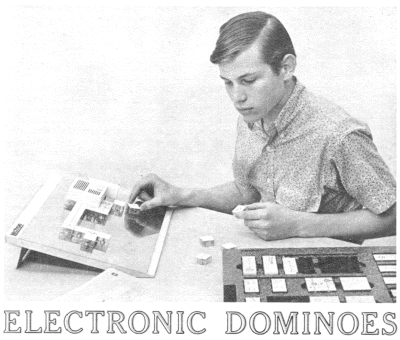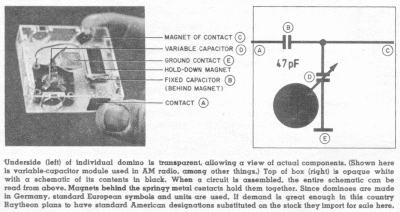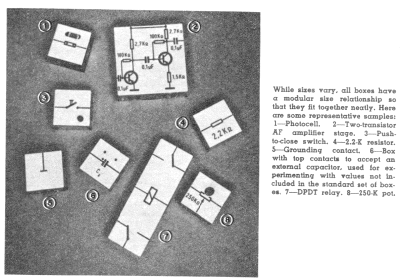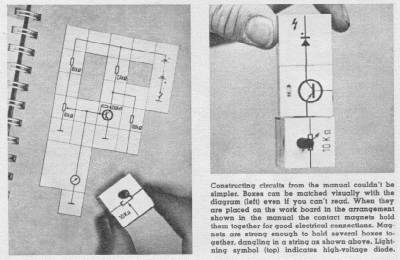Monday, January 31, 2011
A half century of kids playing with Circuitry
 |
| Add caption |
A toy, similar to "Snap Circuits "
" was covered in the September 1967 issue of Electronics Illustrated. Then and now what you get is a box of domino like magnetic pieces that allow kids to snap together such cool items as a radio, a light activated multi-vibrator, a voice activated switch, a solar panel, a burglar alarm and many more. The toymaker today is Elenco Electronics but originally it turns out it was Raytheon, the inventor of radar and the fifth largest military contractor in the world. Revenues of 25,000 billion, employing 75,000 today. An article by Emer Carlson about the 1960's product is below. This toy is equally fascinating today. (Thanks for the link Hal!)
was covered in the September 1967 issue of Electronics Illustrated. Then and now what you get is a box of domino like magnetic pieces that allow kids to snap together such cool items as a radio, a light activated multi-vibrator, a voice activated switch, a solar panel, a burglar alarm and many more. The toymaker today is Elenco Electronics but originally it turns out it was Raytheon, the inventor of radar and the fifth largest military contractor in the world. Revenues of 25,000 billion, employing 75,000 today. An article by Emer Carlson about the 1960's product is below. This toy is equally fascinating today. (Thanks for the link Hal!)
Instant is the word of the jet age. Time grows more valuable every day. Once we spent six days in leisure travel from New York to California by train. Now we can't wait for a supersonic jet to get us there before we leave. And so it is with electronics. There's a mountain of information to learn in what always turns out to be too little time.
To help grease the skids of learning basic electronics and get your hands into practical working circuits, there's a new kit of domino-like plastic electronic boxes. Now, this isn't just an electronic game. It's the way to instant learning.
Big drag when studying electronics is putting circuits together. It's time-consuming to cut and twist component leads, connect them, solder them, support them and keep them from shorting. You have enough to do just learning how a circuit operates. And then think of the mess when you take everything apart for another experiment. Solder drippings, burned finger, broken leads, sloppy layouts, heat-damaged semiconductors - all of this makes you wish you'd never started.
But now it can be as much fun to put electronic circuits together and to learn fundamentals as it is to put words together when you play Scrabble. The Egger-Lectron Model 8400 learning aid is imported from Germany and will be distributed by the Macalaster Scientific Co. (a subsidiary of Raytheon), 186 Third Ave., Waltham, Mass., 02154. In this country they will be called electronic dominoes.
Just about anyone can put together an operating circuit as easily as they could play real dominoes. Each of the plastic boxes contains one or more electronic components or an interconnecting part. The kit supplied to us by Raytheon contains a carefully-selected collection of components, all neatly done up in plastic boxes bearing a schematic symbol of the contents, a manual of experiments and two work boards. Even a 9-year-old child can match the marked dominoes with those on the schematics to build and demonstrate a light meter, electronic thermometer, tone generator or radio - to mention a few of the 90 experiments in the manual that accompanies the complete set. For the high school student, there are more advanced projects such as a three-transistor reflex-AM radio, metering circuits, transistor-testers and simple computer flip-flops.
The three-transistor reflex-AM radio and several smaller circuits were put together in about an hour the first evening we worked with the set. And that included time for experimenting - which is at least half the fun of building the circuits. Of course, if you want to snap the boxes together really fast, give the circuit a quick test, then pull it apart and snap together another circuit. You could do eight or ten circuits in an hour.
The set we show here contains 108 plastic boxes. Sixty-five contain such components as resistors, capacitors, transistors (with and without a bias resistor), a meter, a relay, a thermistor, potentiometers, rheostats, RF transformer, speaker, push-button switches, diodes, variable capacitor, photocell and battery packs. Eight are blanks in which there are small contacts that accept the leads of resistors, capacitors, inductors or transistors for supplying values not included in the set. Jacked boxes will accept special inputs or test leads, for example. Other boxes contain connectors to join boxes to boxes or to ground a component to the work board.
How Does It All Work? In vaudeville they used to say it was all done with mirrors. In Dominoes it's all done with magnets. Instead of using clips, binding posts, or springs to hold parts together, each box is equipped with small magnets at the pointswhere it is ot contact another box or the board. The sides and the bottom of each box are made of clear plastic so you can see what's inside. The top of each box - carrying the schematic symbol - is opaque white.
Some of the circuits can, incidentally, be a little touchy. Squeeze a little here, apply some pressure there and suddenly the circuit works like a charm - a light blinks, the meter needle moves or the speaker sounds. The longer we used the set, however, the less we seemed to have contact problems.
The work surface of each of the 13 x 15-1/2 inch work boards is covered with a plated ferrous metal sheet forming the ground or common connection for all the circuits, just like a radio chassis. Since two battery boxes and two work boards were included in the set, it is possible to put together two circuits at the same time - provided you don't have too many components in each circuits. The concept has great potential as a teaching tool. In only a few seconds it is possible to set up a practical circuit that would only be schematic symbols in a textbook. The work boards can be propped up on their built-in stands or hung on the wall so that a whole classroom can see the demonstration. Componenets in any circuit can be changed instantly to show their effect on circuit performance. Special experiments in the manual demonstrate the characteristics of components - resisitance, inductance and capacitance; how tuned circuits affect radio reception; effects of base current on emitter-collector current flow and other electronic principles.
Okay, let's open the manual and see what we can learn. Believe it or not, the first experiment is a multivibrator flasher made with 21 boxes. Now this is hardly the sort of experiment and the 19 that follow is simply to give you a taste of some of the interesting things to come.
Experiment No. 21 is about as simple as you could want. It consists of a bulb, battery and switch in series. This is basic. In the next two experiments you put resistors in series with battery and lamp to note the effect of adding resistance in the circuit. The lamp, of course, gets dimmer. From there the experiments go on through multivibrators, audio, photocell applications, relays, etc., ending with a burglar alarm.
Everybody who has seem the dominoes has found it hard to keep his hands off them. Their arrival in our New York office threatened to play havoc with production schedules, in fact, until some killjoy remembered that they had been designed for kids. So we sheepishly carted them off to a household that included a bright 14-year-old. He was delighted.
Frist project on the agenda was, of course, the AM radio circuit - even though that's toward the back of the book. It worked and he was hooked. He and his father (who was also hooked by this time) were having a grand time trying circuit after circuit when the eight-year-old kid sister showed up and wanted to play, too. Now this is not quite cricket, according to Raytheon, because the dominoes are geared to high-school instruction. Nothing daunted, she abandoned her numbered painting and pitched in.
It's a good thing that battery packs and work boards supplied in pairs in the set they were using. Otherwise we would have been responsible for introducing dissention into a happy home. As it was, both kids ended up pushing Dad aside and going their, merry, electronic ways. Numbered painting? Who needs it?
Next of the priviledged junior set to get his grubby little hands on the dominoes was a five-year-old. Now we were really on unspoiled ground since this boy had never even heard of a circuit. We tried experiment No. 21. The chocolate-smeared finger gleefully pushed the button of the push-to-close switch while the bulb flashed on and off. Fine - audience participation! But what was he getting out of it, we wondered. Next he wanted to see the meter work so we set up the battery-tester circuit with the same push-to-close switch. More delight.
The experience of a five-year-old can't be expected to add up to a hill of beans, electronically speaking. But it does demonstrate the appeal of the dominoes. It's hard to imagine any other means by which you could get across these basic concepts so quickly and so vividly. The fact that kids can put the parts in place themselves and see immediate results from their efforts beats fussing with Fahnestock clips and interconnecting wires all hollow - to say nothing of messing with soldering irons.
All this is fine in the school. Homebodies may have reservations about the cost, however. A basic starter kit, the Mini Lectron, having pretty limited capabilities, is expected to sell for $19.50. While the way will be eased to biffer and better things by the availability of individual blister-packed add-on units, cost of a full set like the one we had will probably be $128. Two intermediate sets are also planned.
Still, considering the way the Lectron can put across ideas (even to our five-year-old, who corrected a mistake of his father's after only ten minutes with the darn thing), it's got to be one of the grandest educational toys, ever. -Elmer Carlson
Friday, January 28, 2011
Simone's take on Dolphins
Simone gave a presentation in her classroom today about Dolphins. She used questions to start the talk and to lead the way through it. Her peers listened avidly and raised their hands to ask questions or add a note from their own experiences. Here is her talk:
Last summer when my family and I went boogie boarding in California, a pod of dolphins came by and started leaping around us. Then, over the holidays we went to a dolphin park in Cabo, Mexico. Ever since then, I have wanted to learn more about Dolphins. Today I am going to share what I have discovered with you.
1.) Dolphins are Mammals just like us. They are not fish. Mammals are warm-blooded, breathe air, get milk from their mothers', are born alive and have body hair. (Yes dolphins have just a few hairs by their blowholes.)
3.) Calves, Nursing grannies and Pods.

Baby dolphins are called calves and 50% of them die in their first year of life. In the beginning the dolphin mother has to push the calf up to the surface with her nose every time it needs a breath. Often two or three dolphins from the “pod” help protect and care for a newborn.
Later when the dolphin is older but perhaps not quite strong enough to swim to depths of 2000 feet where a delicious squid might be, they stay on the surface with the “nursing grannies” and if they get hungry waiting for the others to return with squid food, they nurse from the older moms. This is one of the many ways that a pod of dolphins works together.
Pods can be as big as thousands but usually have about 300 members.
4.) How do Dolphins sleep without drowning?
Dolphins do not breathe like us. They have to remember to take a breath once or twice a minute. Our bodies do that on their own. Because of this Dolphins can’t go to sleep, so what they do is rest one half of their brain at a time.
5.) What are “Curtains of Death?”


Tunafish and dolphins often swim together in the ocean. The Dolphins swim closer to the surface and the tuna swim below them. Fisherman know that when they see a dolphin leaping about in the ocean, tuna-fish are likely to be below.
When the fisherman dropped their nets they would trap dolphins too and they would die by the hundreds of thousands and thus the nets were named “Curtains of Death.”
(Pull out the can opener from your holster)
My mom said that when she was younger there was an ad on TV where a bunch of kids dressed up like cowboys said, “how do you kill a dolphin?” and then they pulled out can openers from their holsters. The ad got people to stop eating tuna and forced the fisherman to figure out another way to fish!
Today most fisherman use a net that they can drop down so that it closes only over the tuna and lets the dolphins swim out. Today most people are careful to eat cans of tuna that say “Dolphin Safe” on them.
The last thing I want to share is that Dolphins are fun to play with. There skin feels a little like the leaves of this tulip flower or like the thick rubber of this oven glove.

When I rode on the dolphin it felt secure and easy. I held onto the flippers. (Pass around the rubber glove that feels a bit like Dolphin skin.)
The dolphin went about 5 miles per hour but if a dolphin was being chased it can go as fast as 55 miles per hour.
This was fun to share! Thank you for listening!

Last summer when my family and I went boogie boarding in California, a pod of dolphins came by and started leaping around us. Then, over the holidays we went to a dolphin park in Cabo, Mexico. Ever since then, I have wanted to learn more about Dolphins. Today I am going to share what I have discovered with you.
Here are the answers to those questions ….and a few others.
1.) Dolphins are Mammals just like us. They are not fish. Mammals are warm-blooded, breathe air, get milk from their mothers', are born alive and have body hair. (Yes dolphins have just a few hairs by their blowholes.)
2.) How are Dolphins like bats? (Both use Echolocation or sonar to see in the dark. )
Dolphins have individual sounds just like we have names. They make clicks, whistles, squeaks and moans. When they are searching for food in dark or murky water, they make those sounds and then they listen for the echoes that bounce back. In this way, they can find fish hiding under the sand or in a murky stretch of water.
3.) Calves, Nursing grannies and Pods.

Baby dolphins are called calves and 50% of them die in their first year of life. In the beginning the dolphin mother has to push the calf up to the surface with her nose every time it needs a breath. Often two or three dolphins from the “pod” help protect and care for a newborn.
Later when the dolphin is older but perhaps not quite strong enough to swim to depths of 2000 feet where a delicious squid might be, they stay on the surface with the “nursing grannies” and if they get hungry waiting for the others to return with squid food, they nurse from the older moms. This is one of the many ways that a pod of dolphins works together.
Pods can be as big as thousands but usually have about 300 members.
4.) How do Dolphins sleep without drowning?
Dolphins do not breathe like us. They have to remember to take a breath once or twice a minute. Our bodies do that on their own. Because of this Dolphins can’t go to sleep, so what they do is rest one half of their brain at a time.
5.) What are “Curtains of Death?”


Tunafish and dolphins often swim together in the ocean. The Dolphins swim closer to the surface and the tuna swim below them. Fisherman know that when they see a dolphin leaping about in the ocean, tuna-fish are likely to be below.
When the fisherman dropped their nets they would trap dolphins too and they would die by the hundreds of thousands and thus the nets were named “Curtains of Death.”
(Pull out the can opener from your holster)
My mom said that when she was younger there was an ad on TV where a bunch of kids dressed up like cowboys said, “how do you kill a dolphin?” and then they pulled out can openers from their holsters. The ad got people to stop eating tuna and forced the fisherman to figure out another way to fish!
Today most fisherman use a net that they can drop down so that it closes only over the tuna and lets the dolphins swim out. Today most people are careful to eat cans of tuna that say “Dolphin Safe” on them.
The last thing I want to share is that Dolphins are fun to play with. There skin feels a little like the leaves of this tulip flower or like the thick rubber of this oven glove.

When I rode on the dolphin it felt secure and easy. I held onto the flippers. (Pass around the rubber glove that feels a bit like Dolphin skin.)
The dolphin went about 5 miles per hour but if a dolphin was being chased it can go as fast as 55 miles per hour.
This was fun to share! Thank you for listening!

Saturday, January 22, 2011
Birthday
What a great birthday! Thank you! Breakfast in bed, the 1st grade book club and then friends over for a party.
Debbie and Peyman, Monica and David, Margit and Ben, Andrea and Dana, joined David, Naomi, Simone and me for salad, a variation on the cumin rich Judge's stew and scrumptious dark chocolate cake. (Oh and a lovely flan from Margit.)
A delicious take on the Judge's Stew...perhaps I'll call this version the Probationers' Stew.
The fennel, raspberries, goat cheese, soft garden greens and balsamic dressing made this a great salad.
Debbie baked the darkest richest chocolate cake. I saw her 10am post on Facebook about it cooking in her oven, I dreamt I was smelling it for the rest of the day. Finally the moment came and it was even better than my imagination.
Tuesday, January 18, 2011
Selling pigs off a bike
 |
| Hong Kong trip 2000 |
These roasted pigs are barely tied on. There is no hopping curbs or steep hill short cuts for this cyclist. The bike itself becomes the vendor stand at the market. If the pig doesn't sell outright (usually they do) then the vendor cuts off pieces for hungry folks. The grisly ears are popular.
Monday, January 17, 2011
STUFF
Annie Leonard blogs about what went on inside Martin Luther King as he weighed the case at 5AM as to whether or not he would get involved, does he take on the Rosa Parks bus boycott?
She asks every reader to think about whether or not we are going to get involved in making the world a better place and then she makes the case for getting involved. Her mission is the story of stuff and if you haven't seem her project, you are in for a treat. She is funny, keen and full of solutions to the most deadly issues our consumerism has created.
I love my laptop! ...till it runs out of room.
My eyelids have just a wee bit of liner on them. Just a wee bit.
Want to barter with me?
She asks every reader to think about whether or not we are going to get involved in making the world a better place and then she makes the case for getting involved. Her mission is the story of stuff and if you haven't seem her project, you are in for a treat. She is funny, keen and full of solutions to the most deadly issues our consumerism has created.
I love my laptop! ...till it runs out of room.
My eyelids have just a wee bit of liner on them. Just a wee bit.
Want to barter with me?
Subscribe to:
Posts (Atom)


















